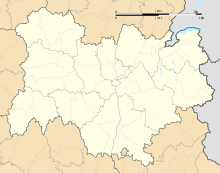Choranche cave
| Choranche cave | |
|---|---|
 Flowstone in Choranche cave. | |
| Location | Choranche, France |
| Coordinates | 45°04′28.6″N 5°23′54.4″E / 45.074611°N 5.398444°E |
| Depth | + 425 metres (1,394 ft) |
| Length | 32,301 metres (105,974 ft) |
| Elevation | 574 metres (1,883 ft) Coufin |
| Geology | Limestone |
The cave of Choranche, also called cave of Coufin-Chevaline, is located in the department of Isère, near Choranche in the Vercors Regional Natural Park and in the Vercors Massif, France.[1] Located at the edge of the massif, its road access is either via the A49 Grenoble - Valence motorway, or by a road entering the massif, near Grenoble.
The entrance to the cave is at the foot of the cliffss of Presles, forming a natural cirque[2] bordering the Coulmes plateau in the Bourne gorge.
In November 2014, the Choranche cave obtained the "Quality tourism" mark.[3]
History
Coufin Cave
Oscar Decombaz, on 7, explored up to the wet vault. In 1949, the defusing of the latter allowed Roger Pénelon and Sage to access Gruyère. In 1954, the Cyclops group went up the Mat waterfall (+116 m (381 ft))[a] and stops at the foot of the large waterfall.
-
Grottes de Coufin in circa 1924.
Chevaline Cave
In 1943, Roger Pénelon, André Bourgin, Sage and Gaché arrived at the cathedral. The speleologists of Grenoble of the CAF resumed explorations in 1960; they go up the river to the Shower. In 1966 the caving club of La Tronche and the Caving Club of the Seine created the junction between the two cavities. The Speleo Group of Valence has continued explorations since 1968. The known network develops 29,489 m (96,749 ft) meters for a positive height difference of 411 m (1,348 ft) on 1 January 1997.[4] In 2009 the known development is 32,301 m (105,974 ft).[5]
Description

Like all karstics cavities, the cave of Choranche was dug by water (erosions hydraulics and hydrochemicals). The active networks are surmounted by large fossil galleries.[6] It contains speleothems in calcite of varied shapes, particularly fistuloses, some of which reach a length of 3 meters. In addition to these concretionss, the cave is crossed by the Serpentine, underground river forming rimstones and an underground lake from which the Karst spring flows in cascade in the "circus of Choranche". The origin of the underground river is to be found in the Coulmes massif.[7]
Species conservation
The Choranche cave constitutes one of the two sites in France where resides (in captivity) the olm, species of blind salamander adapted to karstic caves. Originally from the caves of the Dinaric Alps of the western Balkans, this species was brought to Choranche as well as to the Clamouse cave as part of a research and project to protect the species.
Notes
- ^ In caving, the negative or positive measurements of height levels are defined in relation to at a reference point which is the known entrance to the network, the highest in altitude.
References
- ^ "Discover the site". caves-de-choranche.com (in French).[permanent dead link].
- ^ "Choranche". parc-du-Vercors.fr (in French). 19 May 2006. Archived from the original (pdf) on August 1, 2017. Retrieved May 14, 2017..
- ^ "Coranche, high tourist quality". Spot Magazine, Grenoble edition (in French). No. 125. January 2015. p. 4. Archived from the original on 3 March 2016.
- ^ Caillault et al. 1997, pp. 101–105.
- ^ Dominique Artru (2009). "Speleometry of Isère". Scialet: bulletin of the CDS of Isère (in French) (38). Grenoble: French Federation of Speleology, Isère Departmental Speleology Committee: 176–178. ISSN 0336-0326.
- ^ Jean-Jacques Delannoy (1984). "The Vercors: a mid-Alpine mountain range". Karstologia: journal of karstology and physical speleology of the French Speleology Federation and the French Karstology Association (in French) (1). French Karstology Association. Paris: French Federation of Speleology: 34–45. ISSN 0751-7688. Retrieved May 14, 2017, p. 40.
- ^ Keith Paterson (1974). "Contribution to the study of the underground hydrology of the Presles plateau and the Coulmes massif (Vercors)". Journal of Alpine geography (in French). 49: 241–251. Retrieved 2 December 2021.
Works cited
- Serge Caillault; Dominique Haffner; Thierry Krattinger (April 1997). Spéléo sportive dans le Vercors (in French). Vol. 1. Aix en Provence: Edisud. ISBN 2-85744-897-X. ISSN 0764-2520.
- Pages using gadget WikiMiniAtlas
- CS1 French-language sources (fr)
- All articles with dead external links
- Articles with dead external links from December 2021
- Articles with permanently dead external links
- Coordinates on Wikidata
- Wikipedia cave articles with unreferenced coordinates
- Cave geology
- Isère basin
- Caves of Auvergne-Rhône-Alpes


